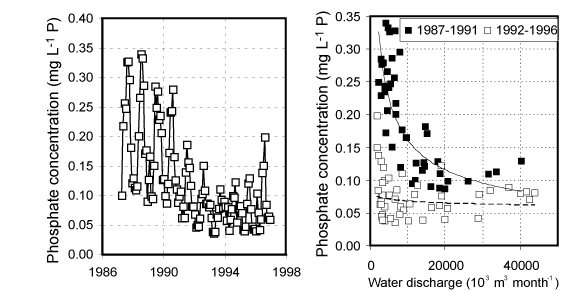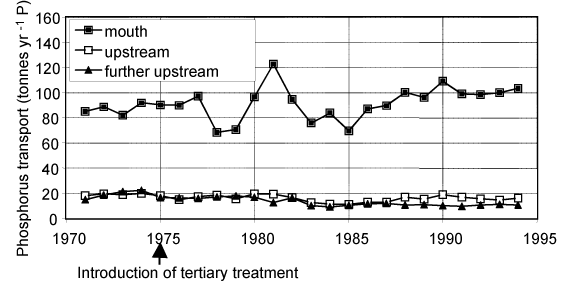


 |  |  | 4.4 Controllability |
There is a widespread conception that it is relatively easy to control riverine loads of phosphorus. Point emissions often play a major role in the most severe cases of river pollution, and efficient techniques for removal of phosphorus can be introduced in existing wastewater treatment systems. The rehabilitation of the Rhine River provides a striking example of how successful such measures can be. When several major point emissions of phosphorus to this river were practically eliminated and phosphorus-containing detergents were phased out in the 1980s, it took less than a decade for the phosphate concentration in the Lower Rhine to reach the much lower level that had prevailed in the 1950s. The results of almost daily measurements in the Odense River in Denmark illustrate more moderate decreases in phosphorus that have been observed in some rivers leading to the Baltic Sea. As can be seen in the next Figure, a downward trend prevailed in 1987-1991, and thereafter the phosphate concentration leveled out. Furthermore, the decrease was accompanied by a significant shift in the relationship between concentration and flow: the concentration peaks that previously appeared during low-flow conditions have been practically absent since 1992, which indicates that the present riverine loads are dominated by non-point sources. It is also noteworthy that the amounts of phosphate leveled out at values exceeding 0.05 mg L-1, which is much higher than the natural background concentration. Hence, it seems to be comparatively easy to reduce phosphorus from high to moderate concentrations, whereas further reduction is a more difficult and time-consuming task.

Observations in the lake-rich Motala River Basin in Sweden provide a thought-provoking example of the inertia of the systems that control the transport of phosphorus with rivers. In the mid 1970s, tertiary treatment was introduced at all major wastewater treatment plants in this basin, and the total point emissions of phosphorus in the study area dropped by almost 200 tons yr-1 to less than 10% of the previous level. In spite of that, the flow-normalized transport of phosphorus at the river mouth has remained at about 100 tons yr-1 for at least 20 years.

The recent dramatic decrease in the use of mineral fertilizers in Eastern Europe has created new possibilities to test hypotheses regarding large-scale fluxes of nitrogen in the Baltic Sea drainage basin. Thus far, studies of small catchments in Estonia have provided clear evidence of downward trends in the output of nitrate with water. In contrast, it is remarkable that no trends have appeared in several major rivers entering the Baltic Sea. Statistical trend assessments of nutrient loads carried by the Daugava and other Latvian rivers showed that most of the interannual variation could be attributed to natural changes in runoff [282]. Moreover, a similar study of the Oder and Vistula Rivers in Poland revealed that the flow-normalized loads remained practically constant from 1989 to 1995.
There are several possible resons for the lack of downward trends in the mentioned rivers. Organic nitrogen accumulated in soil during periods of more extensive use of fertilizers may continue to be an important source of nitrate in agricultural runoff for quite some time. Another plausible explanation is the retention of nitrogen in large groundwater aquifers.
 |  |  | 4.4 Controllability |